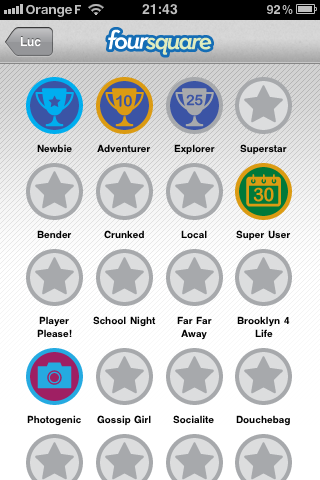Here is a 12 min presentation by Seth Priebatsch – a proud college dropout – explaining us essential things about the gaming fabric that is being installed on top of our social fabric.
According to Priebatsch, last decade was the decade of the social fabric, where “the framework in which we connect with other people” was built. This decade is the one where the gaming framework will be built.
He continues by saying that the first version of this game layer already exists. There are already games like loyalty schemes and airline mile programs. The only problem is that they are boring.
Four Gaming Dynamics
Seth’s mission is to improve the game layer on top of the world. He shares 4 dynamics that are essential for the gaming fabric of our society.
Appointment dynamic: a dynamic in which to succeed, one must return at a predefined time to take a predetermined action. The dynamic of a ‘happy hour’ is a good example of the appointment dynamic because it influences our behavior and our entire culture by ‘being somewhere at the right time. A more recent example is Farmville (which has more active users than Twitter!!) where the crop cycles influence when people log on.
‘So far so good’ you may think… but what about inducing this same behavioral dynamic into healthcare, where products like GlowCaps improve medication adherence through reminders, social feedback, financial incentives and automatic refills. According to Priebatsch:
This is not a game yet. They should get points for doing this on time. You should lose points for not doing this on time. They should recognize that they have built an appointment dynamic and then consciously leverage the game.
Influence and status: the ability of one player to modify the behavior of another’s actions through social pressure. Examples include the status color of your credit card; the recognition you get on your profile on World of Warcraft.
It can also be used consciously in more conventional settings, like grades at school. It’s just not well designed because we are not designing the dynamic consciously.
Progression dynamic: a dynamic in which success is granularly displayed and measured through the process. You need to move through different steps. A good example is the completeness of your profile on LinkedIn, where we want to reach the 100%.
Communal Discovery: a dynamic wherein an entire community is rallied to work together to solve a challenge. A good example is Digg, where good stories and good news is promoted.
An Example: Foursquare
Foursquare is another example, combining different dynamics: that of status and progression. It is a ‘checking in’ system that enables you to tell your friends exactly where you are in the world using a GPS from your phone.
With a game-like feel you unlock badges and earn points each time you check in somewhere. Very addictive. You can even become the ‘mayor’ of somewhere when you check in enough times. You can also make recommendations about the places you are, like recommending a dish in a restaurant. Your tip will be visible to others as they check in this place.
Fourquare creates a game layer on top of the geographic reality. You can go to a restaurant in the real world for a fine dining experience.
With Foursquare you can add a game layer to that experience: outset the mayor of that restaurant on Foursquare, check what other visitors tell about the food and the service and even see if anyone in your network is there at the same time.
Upgrading Organizational Change Management
In recent years the literature on organizational change management has started to include insights on how to shape an environment, a project or any initiative in order to achieve successful behavior change.
In their 2009 book Nudge Improving Decisions About Health, Wealth, and Happiness, Thaler & Sunstein made the case for choice architecture. Their premise is that the context in which you make a decision always shapes your choices. In their own words:
A nudge…is any aspect of the choice architecture that alters people’s behavior in a predictable way without forbidding options or significantly changing their economic incentives.
In the same way as Priebatsch is promoting a conscious use of the dynamics that construct the gaming dynamic, Thaler & Sunstein tell us to set up choices in a way that takes advantage of how humans make decisions.
Another recent best-seller in our field is Switch, written by the Heath brothers. The authors use the analogy of an elephant and its rider. The rider represents the rational and logical. The Elephant, on the other hand, represents our emotions, our gut response. This complete book is built up around the phases of influencing behavior: Direct the rider, Motivate the elephant and shape the path.
I think the insights of Seth Priebatsch represent an upgrade and in some ways offer a more conscious way to fine-tune the steps of this method.
A final example worth noting is Brain Wansink’s research on Mindless Eating. The point here is that dinner control starts with plate control. And you often have more tools available than you think: small tweaks to the environment that yield big results.
The question here could be: how can we introduce the above dynamics into the management of eating behavior?
The Moral
Organizational Change Management is always in search of instruments to navigate the behavior of a target audience. The new literature has been giving us good guidance on how to consciously do that.
But in the mean time the world has changed. The internet has upgraded the social fabric of our society, and now we are in the middle of upgrading the gaming fabric of our society.
The invitation for us is to grab the opportunity and to make conscious use of the fact that our employees are already using Facebook, Wikipedia, instant messaging, and many other technologies. Then – and only then – can we empower them to leverage them to the benefit of our companies.
This requires us to go beyond sanctioning social networking and encourage and empower employees to become proactive problem solvers. “Shaping the path” needs an upgrade as we are adding a game layer. Let’s not hold it off any longer.










Pingback: Tweets that mention Gamers Will Save Our Economy (Part 4) | Reply-MC -- Topsy.com()
Pingback: Tweets that mention Gamers Will Save Our Economy (Part 4) | Reply-MC -- Topsy.com()
Pingback: Learning Heaps from Hypes | Reply-MC()